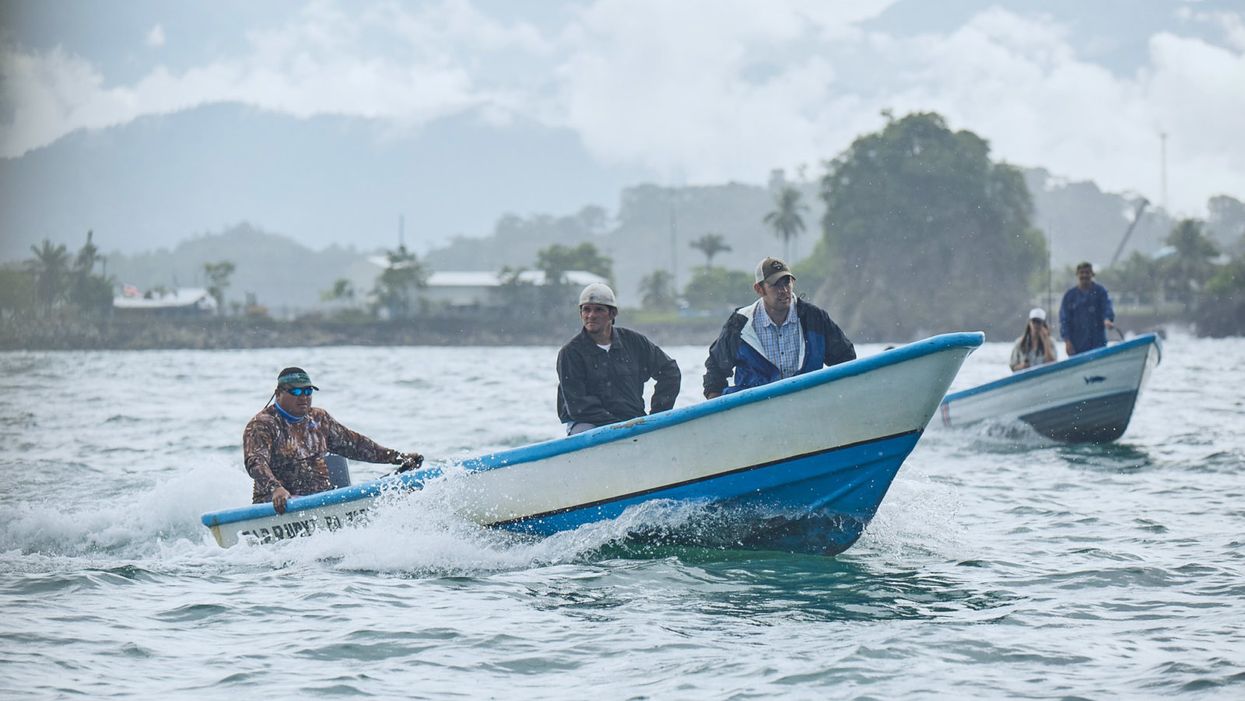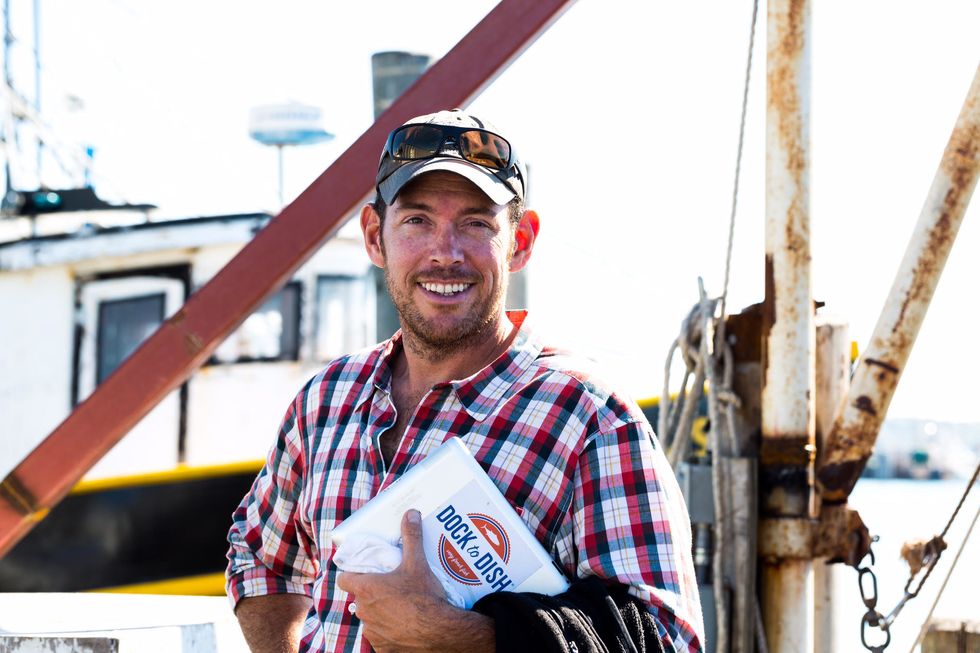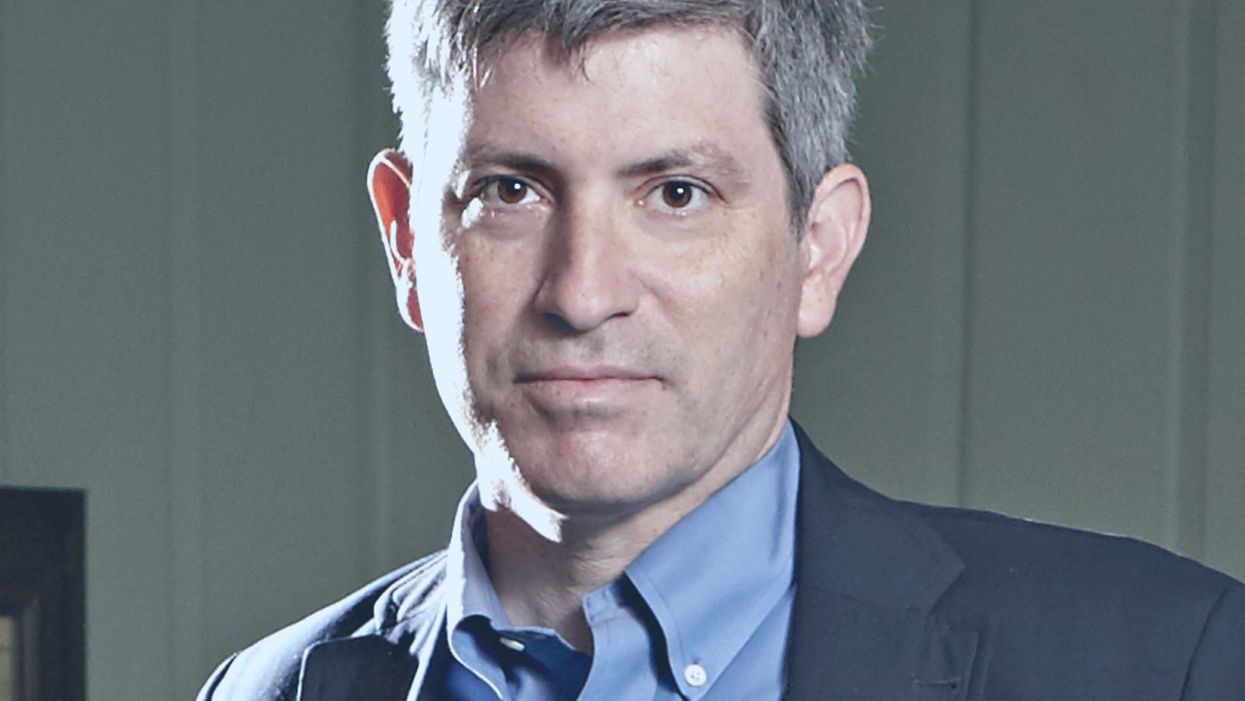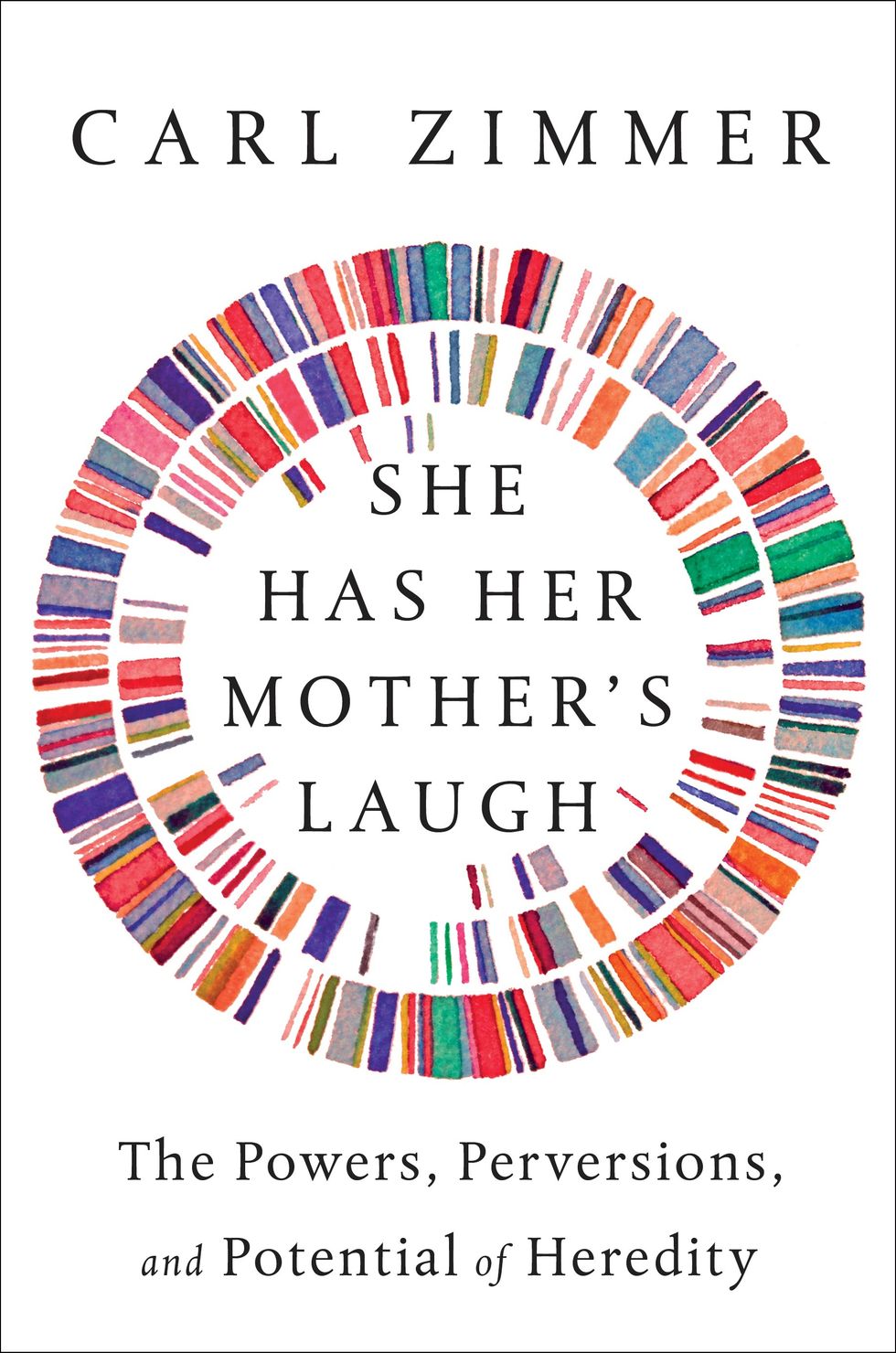Wild-Caught Seafood Has Been Notoriously Shady – Until Now
The Dock to Dish model has expanded across North and Central America. Above, artisanal fishermen on the Pacific coast of Costa Rica head out to sea seeking schools of abundant forage fish to supply the program.
In 2012, entrepreneur Sean Barrett founded Dock to Dish in Montauk, New York. It connected local fishermen and women with local chefs, enabling the chefs to serve hyper-fresh seafood – with the caveat that they didn't know what would be on their menus until it arrived in their kitchens the night before.
"Since we're not a seafood-centric culture, people don't know what's what, where fish are from, and when they're in season, making them easy to dupe."
In June of 2017, The United Nations Foundation designated Dock to Dish as one of the top breakthrough innovations that can scale to solve the ocean's grand challenges. His company has since expanded across the Americas and has just opened up shop in Fiji. Leapsmag recently chatted with Barrett about his inspirations and ideas for how to overcome the hurdles of farming wild seafood. This interview has been edited and condensed for clarity.
What inspired you to start Dock to Dish?
The short story is "A Tale of Two Hills."
The first is Quail Hill Farm in Amagansett. I grew up in the commercial fishing port of Chinicock in the 1980's and 90's, working on my family's dock from an early age and in the restaurant industry in my teens. By my thirties, I had accrued my 10,000 hours of experience in both dock and dish. I watched the food system shift from local to global, especially in seafood. By the early 2000's, over 90 percent of seafood in the U.S. was imported. It was bad.
Quail Hill was the first CSA [Community Supported Agriculture, in which customers pay up front for a share in whatever crops grow (or don't) on the farm that season] in the U.S., founded in 1990. So people in the area were accustomed to getting their produce that way. Scott Chaskey, the poet farmer at Quail Hill, really helped crystallize the philosophy for me and inspired me to apply it to seafood. Fishermen had always been bringing a share of their day's catch to their neighbors; now we were just doing it in a more formalized way.
The second is Blue Hill at Stone Barns. [Executive chef and co-owner] Dan Barber literally trademarked the phrase "Know Thy Farmer"; we just expanded it to Know Thy Fisherman and it took off like a rocket ship. His connections in the restaurant world were also indispensable.
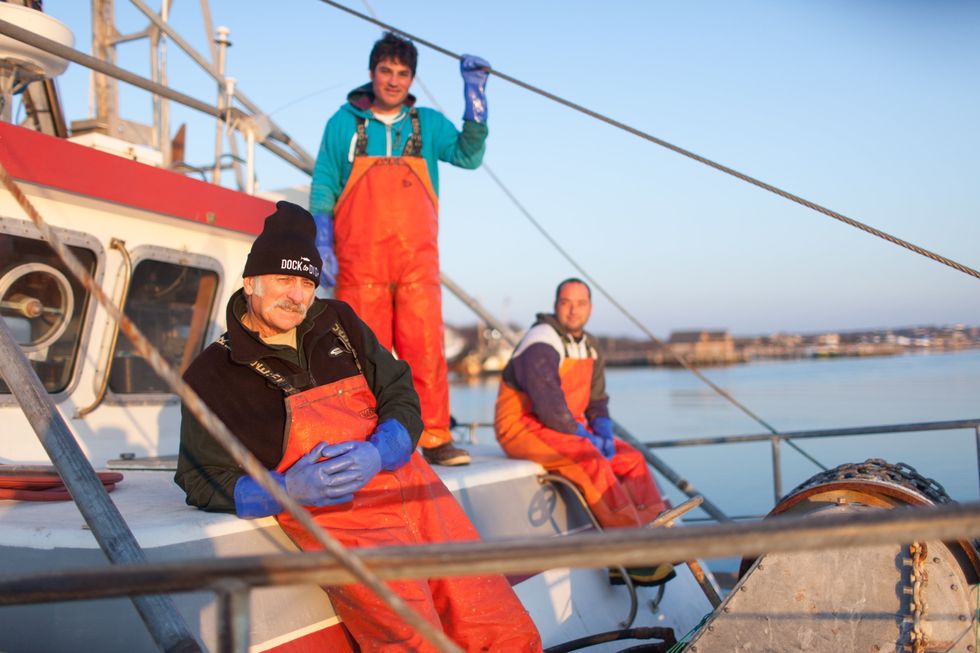
17th generation Montauk fisherman Captain Bruce Beckwith (above left) with crew Charlie Etzel (Center) and Jeremy Gould (right).
Do you have any issues that are unique to seafood that a CSA or meat co-op wouldn't face?
This food is WILD. People are totally disconnected from what that word means, and it makes seafood different from everything else. Everything changes when viewed through the prism of that word.
This is the last wild food we eat. It is unpredictable, and subject to variables ranging from currents and tides to which way the wind is blowing. But it is what makes our model so much more impactful and beneficial than the industrialized, demand-driven marketplace that surrounds us. The ocean and its ecosystem are the boss, not chefs and consumers.
There has a been a lot of press about seafood being mislabeled. How and why does that happen? Can Dock to Dish fix it?
Imported, farmed seafood is cheap. Wild, sustainable seafood is not. People are buying low and selling high to make a buck; and while fisheries are extraordinarily regulated, the marketplace isn't. There is no punishment for mislabeling, and no means to correct it. Since we're not a seafood-centric culture, people don't know what's what, where fish are from, and when they're in season, making them easy to dupe. But technology is poised to fix that; DNA testing can test what a fish sample is and where it's from, and SciO handheld spectrometers – soon to be incorporated into smartphones – can analyze the molecular makeup of anything on your plate.
We've created the first ever live tracking system and database for wild fisheries. It is similar to the electronic system used to monitor commercial fisheries, thanks to which the resurgence of wild seafood in U.S. waters is a model for the rest of the world. We have vessel tracking devices on our fishing boats and delivery vans, so the path of each fish is publicly available in real time.
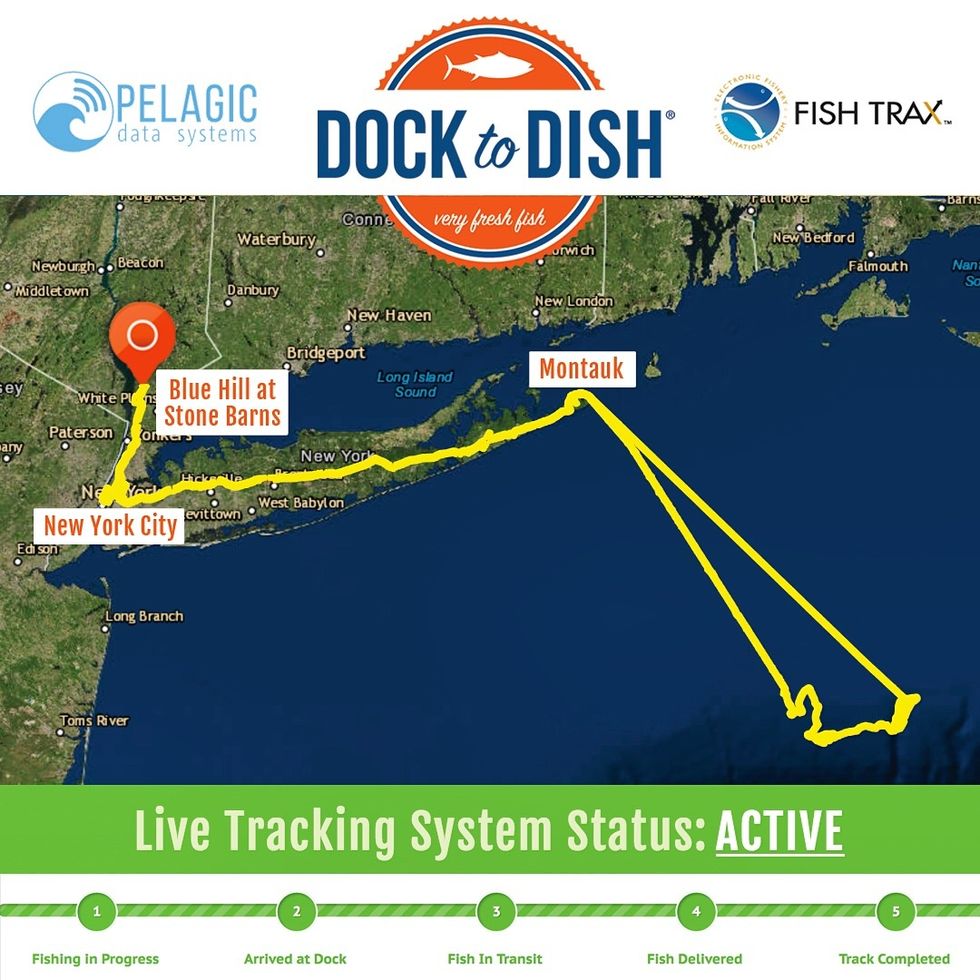
In 2017, Dock to Dish launched the world's first live "end-to-end" tracking system for wild seafood, which provides full chain transparency and next-generation traceability for members.
People are increasingly looking to seafood as a healthier, possibly more sustainable protein option than meat. Can Dock to Dish scale up to accommodate this potentially growing market?
Nope. We can't scale; the supply is finite. That's why the price keeps going up. To avoid becoming "fish for the rich" we are working closely with Greenwave.org to create a network of 3D restorative ocean farms growing kelp and shellfish, which sequester carbon and nitrogen out of the air and soil. Restorative, because sustainable is no longer an option. In fifty years, a plate of seafood will be mostly ocean vegetables with a small amount of finfish as a garnish.
Carl Zimmer: Genetically Editing Humans Should Not Be Our Biggest Worry
The award-winning New York Times science writer Carl Zimmer.
Carl Zimmer, the award-winning New York Times science writer, recently published a stellar book about human heredity called "She Has Her Mother's Laugh." Truly a magnum opus, the book delves into the cultural and scientific evolution of genetics, the field's outsize impact on society, and the new ways we might fundamentally alter our species and our planet.
"I was only prepared to write about how someday we would cross this line, and actually, we've already crossed it."
Zimmer spoke last week with editor-in-chief Kira Peikoff about the international race to edit the genes of human embryos, the biggest danger he sees for society (hint: it's not super geniuses created by CRISPR), and some outlandish possibilities for how we might reproduce in the future. This interview has been edited and condensed for clarity.
I was struck by the number of surprises you uncovered while researching human heredity, like how fetal cells can endure for a lifetime in a mother's body and brain. What was one of the biggest surprises for you?
Something that really jumped out for me was for the section on genetically modifying people. It does seem incredibly hypothetical. But then I started looking into mitochondrial replacement therapy, so-called "three parent babies." I was really surprised to discover that almost by accident, a number of genetically modified people were created this way [in the late 90s and early 2000s]. They walk among us, and they're actually fine as far as anyone can tell. I was only prepared to write about how someday we would cross this line, and actually, we've already crossed it.
And now we have the current arms race between the U.S. and China to edit diseases out of human embryos, with China being much more willing and the U.S. more reluctant. Do you think it's more important to get ahead or to proceed as ethically as possible?
I would prefer a middle road. I think that rushing into tinkering with the features of human heredity could be a disastrous mistake for a lot of reasons. On the other hand, if we completely retreat from it out of some vague fear, I think that we won't take advantage of the actual benefits that this technology might have that are totally ethically sound.
I think the United Kingdom is actually showing how you can go the middle route with mitochondrial replacement therapy. The United States has just said nope, you can't do it at all, and you have Congressmen talking about how it's just playing God or Frankenstein. And then there are countries like Mexico or the Ukraine where people are doing mitochondrial replacement therapy because there are no regulations at all. It's a wild west situation, and that's not a good idea either.
But in the UK, they said alright, well let's talk about this, let's have a debate in Parliament, and they did, and then the government came up with a well thought-through policy. They decided that they were going to allow for this, but only in places that applied for a license, and would be monitored, and would keep track of the procedure and the health of these children and actually have real data going forward. I would imagine that they're going to very soon have their first patients.
As you mentioned, one researcher recently traveled to Mexico from New York to carry out the so-called "three-parent baby" procedure in order to escape the FDA's rules. What's your take on scientists having to leave their own jurisdictions to advance their research programs under less scrutiny?
I think it's a problem when people who have a real medical need have to leave their own country to get truly effective treatment for it. On the other hand, we're seeing lots of people going abroad to countries that don't monitor all the claims that clinics are making about their treatments. So you have stem cell clinics in all sorts of places that are making all sorts of ridiculous promises. They're not delivering those results, and in some cases, they're doing harm.
"Advances in stem cell biology and reproductive biology are a much bigger challenge to our conventional ideas about heredity than CRISPR is."
It's a tricky tension for sure. Speaking of gene editing humans, you mention in the book that one of the CRISPR pioneers, Jennifer Doudna, now has recurring nightmares about Hitler. Do you think that her fears about eugenics being revived with gene editing are justified?
The word "eugenics" has a long history and it's meant different things to different people. So we have to do a better job of talking about it in the future if we really want to talk about the risks and the promises of technology like CRISPR. Eugenics in its most toxic form was an ideology that let governments, including the United States, sterilize their own citizens by the tens of thousands. Then Nazi Germany also used eugenics as a justification to exterminate many more people.
Nobody's talking about that with CRISPR. Now, are people concerned that we are going to wipe out lots of human genetic diversity with it? That would be a bad thing, but I'm skeptical that would actually ever happen. You would have to have some sort of science fiction one-world government that required every new child to be born with IVF. It's not something that keeps me up at night. Honestly, I think we have much bigger problems to worry about.
What is the biggest danger relating to genetics that we should be aware of?
Part of what made eugenics such a toxic ideology was that it was used as a justification for indifference. In other words, if there are problems in society, like a large swath of people who are living in poverty, well, there's nothing you can do about it because it must be due to genetics.
If you look at genetics as being the sole place where you can solve humanity's problems, then you're going to say well, there's no point in trying to clean up the environment or trying to improve human welfare.
A major theme in your book is that we should not narrow our focus on genes as the only type of heredity. We also may inherit some epigenetic marks, some of our mother's microbiome and mitochondria, and importantly, our culture and our environment. Why does an expanded view of heredity matter?
We should think about the world that our children are going to inherit, and their children, and their children. They're going to inherit our genes, but they're also going to inherit this planet and we're doing things that are going to have an incredibly long-lasting impact on it. I think global warming is one of the biggest. When you put carbon dioxide into the air, it stays there for a very, very long time. If we stopped emitting carbon dioxide now, the Earth would stay warm for many centuries. We should think about tinkering with the future of genetic heredity, but I think we should also be doing that with our environmental heredity and our cultural heredity.
At the end of the book, you discuss some very bizarre possibilities for inheritance that could be made possible through induced pluripotent stem cell technology and IVF -- like four-parent babies, men producing eggs, and children with 8-celled embryos as their parents. If this is where reproductive medicine is headed, how can ethics keep up?
I'm not sure actually. I think that these advances in stem cell biology and reproductive biology are a much bigger challenge to our conventional ideas about heredity than CRISPR is. With CRISPR, you might be tweaking a gene here and there, but they're still genes in an embryo which then becomes a person, who would then have children -- the process our species has been familiar with for a long time.
"We have to recognize that we need a new language that fits with the science of heredity in the 21st century."
We all assume that there's no way to find a fundamentally different way of passing down genes, but it turns out that it's not really that hard to turn a skin cell from a cheek scraping into an egg or sperm. There are some challenges that still have to be worked out to make this something that could be carried out a lot in labs, but I don't see any huge barriers to it. Ethics doesn't even have the language to discuss the possibilities. Like for example, one person producing both male and female sex cells, which are then fertilized to produce embryos so that you have a child who only has one parent. How do we even talk about that? I don't know. But that's coming up fast.
We haven't developed our language as quickly as the technology itself. So how do we move forward?
We have to recognize that we need a new language that fits with the science of heredity in the 21st century. I think one of the biggest problems we have as a society is that most of our understanding about these issues largely comes from what we learned in grade school and high school in biology class. A high school biology class, even now, gets up to Mendel and then stops. Gregor Mendel is a great place to start, but it's a really bad place to stop talking about heredity.
[Ed. Note: Zimmer's book can be purchased through your retailer of choice here.]
Kira Peikoff was the editor-in-chief of Leaps.org from 2017 to 2021. As a journalist, her work has appeared in The New York Times, Newsweek, Nautilus, Popular Mechanics, The New York Academy of Sciences, and other outlets. She is also the author of four suspense novels that explore controversial issues arising from scientific innovation: Living Proof, No Time to Die, Die Again Tomorrow, and Mother Knows Best. Peikoff holds a B.A. in Journalism from New York University and an M.S. in Bioethics from Columbia University. She lives in New Jersey with her husband and two young sons. Follow her on Twitter @KiraPeikoff.
Why Haven’t Researchers Developed an HIV Vaccine or Cure Yet?
A blood test for analysis of HIV.
Last week, top experts on HIV/AIDS convened in Amsterdam for the 22nd International AIDS conference, and the mood was not great. Even though remarkable advances in treating HIV have led to effective management for many people living with the disease, and its overall incidence has declined, there are signs that the virus could make a troubling comeback.
"In a perfect world, we'd get a vaccine like the HPV vaccine that was 100% effective and I think that's ultimately what we're going to strive for."
Growing resistance to current HIV drugs, a population boom in Sub-Saharan Africa, and insufficient public health resources are all poised to contribute to a second AIDS pandemic, according to published reports.
Already, the virus is nowhere near under control. Though the infection rate has declined 47 percent since its peak in 1996, last year 1.8 million people became newly infected with HIV around the world, and 37 million people are currently living with it. About 1 million people die of AIDS every year, making it the fourth biggest killer in low-income countries.
Leapsmag Editor-in-Chief Kira Peikoff reached out to Dr. Carl Dieffenbach, Director of the Division of AIDS at the National Institute of Allergy and Infectious Diseases, to find out what the U.S. government is doing to develop an HIV vaccine and cure. This interview has been edited and condensed for clarity.
What is the general trajectory of research in HIV/AIDS today?
We can break it down to two specific domains: focus on treatment and cure, and prevention.
Let's start with people living with HIV. This is the area where we've had the most success over the past 30 plus years, because we've taken a disease that was essentially a death sentence and converted it through the development of medications to a treatable chronic disease.
The second half of this equation is, can we cure or create a functional cure for people living with HIV? And the definition of functional cure would be the absence of circulating virus in the body in the absence of therapy. Essentially the human body would control the HIV infection within the individual. That is a much more, very early research stage of discovery. There are some interesting signals but it's still in need of innovation.
I'd like to make a contrast between what we are able to do with a virus called Hepatitis C and what we can do with the virus HIV. Hep C, with 12 weeks of highly active antiviral therapy, we can cure 95 to 100% of infections. With HIV, we cannot do that. The difference is the behavior of the virus. HIV integrates into the host's genome. Hep C is an RNA virus that stays in the cytoplasm of the cell and never gets into the DNA.
On the prevention side, we have two strategies: The first is pre-exposure prophylaxis. Then of course, we have the need for a safe, effective and durable HIV vaccine, which is a very active area of discovery. We've had some spectacular success with RV144, and we're following up on that success, and other vaccines are in the pipeline. Whether they are sufficient to provide the level of durability and activity is not yet clear, but progress has been made and there's still the need for innovation.
The most important breakthrough in the past 5 to 10 years has been the discovery of broad neutralizing monoclonal antibodies. They are proteins that the body makes, and not everybody who's HIV infected makes these antibodies, but we've been able to clone out these antibodies from certain individuals that are highly potent, and when used either singly or in combination, can truly neutralize the vast majority of HIV strains. Can those be used by themselves as treatment or as prevention? That is the question.
Can you explain more about RV144 and why you consider it a success?
Prior to RV144, we had run a number of vaccine studies and nothing had ever statistically shown to be protective. RV144 showed a level of efficacy of about 31 percent, which was statistically significant. Not enough to take forward into other studies, but it allowed us to generate some ideas about why this worked, go back to the drawing board, and redesign the immunogens to optimize and test the next generation for this vaccine. We just recently opened that new study, the follow-up to RV144, called HVTN702. That's up and enrolling and moving along quite nicely.

Carl Dieffenbach, Director of the Division of AIDS at the National Institute of Allergy and Infectious Diseases
(Courtesy)
Where is that enrolling?
Primarily in Sub-Saharan Africa and South Africa.
When will you expect to see signals from that?
Between 2020 and 2021. It's complicated because the signal also takes into account the durability. After a certain time of vaccination, we're going to count up endpoints.
How would you explain the main scientific obstacle in the way of creating a very efficacious HIV vaccine?
Simply put, it's the black box of the human immune system. HIV employs a shield technology, and the virus is constantly changing its shield to protect itself, but there are some key parts of the virus that it cannot shield, so that's the trick – to be able to target that.
So, you're trying to find the Achilles' Heel of the virus?
Exactly. To make a flu vaccine or a Zika vaccine or even an Ebola vaccine, the virus is a little bit more forthcoming with the target. In HIV, the virus does everything in its power to hide the target, so we're dealing with a well-adapted [adversary] that actively avoids neutralization. That's the scientific challenge we face.
What's next?
On the vaccine side, we are currently performing, in collaboration with partners, two vaccine trials – HVTN702, which we talked about, and another one called 705. If either of those are highly successful, they would both require an additional phase 3 clinical trial before they could be licensed. This is an important but not final step. Then we would move into scale up to global vaccination. Those conversations have begun but they are not very far along and need additional attention.
What percent of people in the current trials would need to be protected to move on to phase 3?
Between 50 and 60 percent. That comes with this question of durability: how long does the vaccine last?
It also includes, can we simplify the vaccine regimen? The vaccines we're testing right now are multiple shots over a period of time. Can we get more like the polio or smallpox vaccine, a shot with a booster down the road?
We're dealing with sovereign nations. We're doing this in partnership, not as helicopter-type researchers.
If these current trials pan out, do you think kids in the developed world will end up getting an HIV vaccine one day? Or just people in-at risk areas?
That's a good question. I don't have an answer to that. In a perfect world, we'd get a vaccine like the HPV vaccine that was 100% effective and I think that's ultimately what we're going to strive for. That's where that second or third generation of vaccines that trigger broad neutralizing antibodies come in.
With any luck at all, globally, the combination of antiretroviral treatment, pre-exposure prophylaxis and other prevention and treatment strategies will lower the incidence rate where the HIV pandemic continues to wane, and we will then be able to either target the vaccine or roll it out in a way that is both cost effective and destigmatizing.
And also, what does the country want? We're dealing with sovereign nations. We're doing this in partnership, not as helicopter-type researchers.
How close do you think we are globally to eradicating HIV infections?
Eradication's a big word. It means no new infections. We are nowhere close to eradicating HIV. Whether or not we can continue to bend the curve on the epidemic and have less infections so that the total number of people continues to decline over time, I think we can achieve that if we had the political will. And that's not just the U.S. political will. That's the will of the world. We have the tools, albeit they're not perfect. But that's where a vaccine that is efficacious and simple to deliver could be the gamechanger.
Kira Peikoff was the editor-in-chief of Leaps.org from 2017 to 2021. As a journalist, her work has appeared in The New York Times, Newsweek, Nautilus, Popular Mechanics, The New York Academy of Sciences, and other outlets. She is also the author of four suspense novels that explore controversial issues arising from scientific innovation: Living Proof, No Time to Die, Die Again Tomorrow, and Mother Knows Best. Peikoff holds a B.A. in Journalism from New York University and an M.S. in Bioethics from Columbia University. She lives in New Jersey with her husband and two young sons. Follow her on Twitter @KiraPeikoff.
